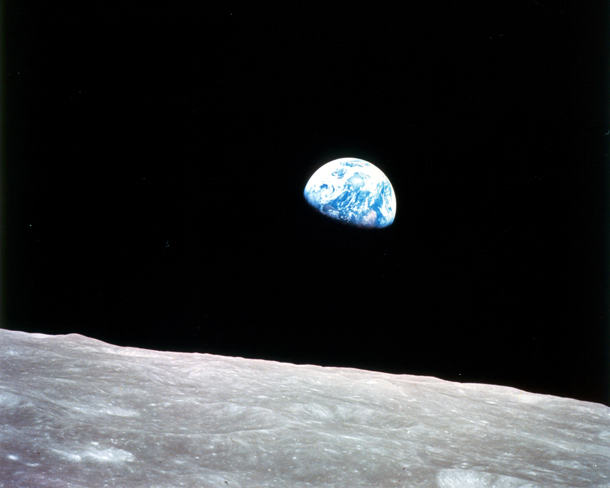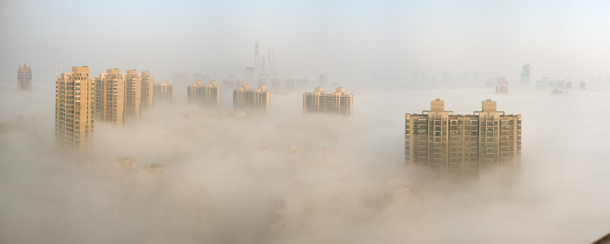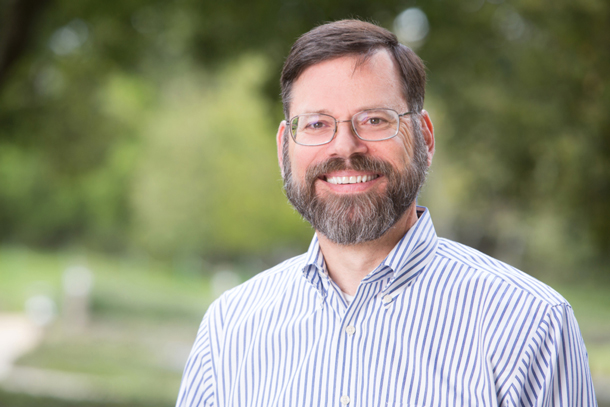Earth Day Checkup
Air Date: Week of April 19, 2019

Earthrise is the image of planet Earth taken from the Apollo spacecraft during the first manned mission to the moon, led by NASA in 1968. This event has continuously sparked interest in the beauty of the earth, and the possibilities brought forth by science. (Photo: NASA, www.earthday.org, Public Domain)
Every April 22nd since 1970 we celebrate Earth Day. And since that first Earth Day much has been done to clean up our air and water, here in the U.S. and elsewhere. But the world isn’t yet curbing carbon emissions fast enough, and the leadership that the U.S. once showed on the climate crisis has almost vanished. Jonathan Pershing led the U.S. delegation to the UN climate talks during the Obama Administration and discusses with Host Steve Curwood the current global outlook for addressing climate disruption.
Transcript
CURWOOD: It’s Living on Earth, I’m Steve Curwood.
Every April 22 since 1970 we celebrate Earth Day. And since that first Earth Day the water in the US is cleaner, and local air less polluted, but carbon pollution of the entire atmosphere of the planet has gotten worse and is changing our climate. The leadership that the U.S. government once showed on the climate crisis has almost vanished as President Trump vows to pull this country out of the landmark Paris Climate Agreement of 2015. Other big emitters like China and India are making big progress on renewable energy deployment, but face a difficult transition away from dependence on carbon heavy coal. To talk about these global responses to the climate challenge, we turn now to Jonathan Pershing, who led the US delegation to the UN climate negotiations during the Obama Administration. Jonathan is currently the Program Director of Environment at the Hewlett Foundation. Welcome to Living on Earth!
PERSHING: Great, thanks very much for having me.
CURWOOD: Jonathan Pershing, what is it costing the United States in terms of moral leadership to have backed away from the Paris Climate Agreement at this point?
PERSHING: I think it’s immense. The world is very, very clear about its own collective recognition of the severity of the problem. The United States actually turns out to have impacts that are significant, but they are dwarfed by the impacts that are faced by others. Just a few examples of places that people think about in the, in the news these days: we're having whole conversations around places like Bangladesh, where 10 million people are likely to be flooded out with only one foot of sea level rise. Where do they go? This is a very poor country, in a region that is currently quite volatile. Do they move into India? And what will India do with 10 million Bangladeshis moving in? Or take a look at what's going on now in Latin America. Latin America, clearly suffering in a number of different ways from a change in the climate today. Those are things that lead to a change in agricultural productivity, those in turn to a loss in jobs, those in turn to an increase in out migration from populations where there's nothing left at home. And where are they coming? Some are coming here. And we have those problems already today, already as a consequence, in part, of climate change; it's going to get worse. This is a part of the world in which 25% or more lives off of agriculture, and those damages are real. And those countries look at the US and say, You are one of the reasons we are being forced to leave. You, with your ways of significant emissions; if you curtailed, we'd have a much more promising future. Why can't you, why aren't you leading? We rely on you as a major partner in the global community, as a leader, to do just that. And when you back away, that has moral consequences, it has diplomatic consequences, it has consequences in terms of how people perceive us, not only in this arena, but in much wider arrays of climate and foreign policy.

Local air pollution in China has made coal power-related emissions related to climate change a key concern of its policies. China is now the leading investor on the world’s clean energy systems. (Photo: Leniners, Flickr, CC BY-NC 2.0)
CURWOOD: Now, talk to me about, briefly, what the rest of the world is doing at this moment to deal with the climate emergency. Perhaps you want to start with China.
PERSHING: So I think countries have each chosen a somewhat different path. And that's to be expected. Each country will have its own circumstances, each country has its own opportunities. And so each country is choosing slightly different things to prioritize. Some, and the US is certainly one, is a diverse economy, with enormous landmass, with needs and change required in different parts of our country that would vary. You wouldn't expect Denver to do what you'd see in Detroit. These kinds of dynamics play out. And in a country as big as China, as another example, the same kinds of diversity holds. China's taking this quite seriously. In many ways, the government is run by a group of people who see the science as not only credible, but as urgent, who see impacts around their nation as being both immediate and far reaching, who have designs on the future, both in terms of the technology development, and in terms of protecting the nation against some of the worst impacts of climate, as being consistent with their vision of the future. What does that look like? Well, at one end, China's decided to go all-in on electric vehicles. So it turns out that transportation, and the heaviest part of that is cars and trucks, are responsible for about a quarter of global greenhouse gas emissions. And we think that one of the futures for that sector is electric vehicles. China is leading in that regard, not just light-duty cars, but also things like buses. There's a city called Shenzhen, it is a city that has about 17,000 buses. Compare for a moment that to New York City. New York City only has 9000. Nearly twice as many buses in Shenzhen as in New York. They have electrified all 17,000 of those buses in the last three years.
CURWOOD: China has passed the United States in terms of absolute emissions, but not at all in per capita emissions. How are the Chinese doing, moving to the low or no-carbon economy, both in terms of the technology that they've deployed and the financial position that they have themselves in, compared to the US.
PERSHING: China has been the single largest reason for global growth in renewables, more renewables installed there than any other country in the world. But at the same time, for much of that period, Chinese demand has been growing. So instead of retiring one and replacing it with clean -- retiring coal and replacing it with solar -- you've added solar, you've added wind to the existing mix. The United States has been doing some of the same things, reducing a little bit, but mostly it's been about adding. In our case, we've added it, and what's replaced coal has been natural gas. That still has carbon emissions. So in that sense, our collective emissions have not declined as much as we thought. We went through a period of about a decade where U.S. emissions were slightly down; in the last couple of years, they've been inching back up. And that's a very, very daunting prospect as we look at the rate of change that is still required to solve the climate problem. China's in a similar place. This last year, Chinese emissions also went up, about the same percentage as ours did, actually; we're not all that different. But again, there, we represent the two largest greenhouse gas emitters in the world. And unless both of us can figure out how to change our trends, the world has only a slim chance of meeting our goals.

The city of Shenzhen, China, has the largest concentration of electric buses in the world. The transition to electric has helped reduce both smog and noise pollution. (Photo: Hans Johnson, Flickr, CC-BY ND 2.0)
CURWOOD: By the way, what role is India playing? At the Paris gathering, Prime Minister Modi, who may or may not be reelected, pledged a trillion dollar fund to solarize much of the developing world and that they would get out of the coal business and move forward with renewable energies.
PERSHING: So I think it's a very -- at this instant, during the course of the election, it's a little hard to say what India is going to do next. I had the good fortune of being there just a few weeks ago, and had a set of conversations with a variety of officials in the government. And the sense that I took away from those meetings is that under the Modi administration, or even were he not to win, under a new administration, there is a commitment to this issue. That includes a commitment because of air quality, and that's largely driven by coal pollution, to really cutting back on their coal use. That's a commitment to being competitive in the global marketplace, including vis-a-vis China, and that means having the capacity to build their own renewables, including for export. That means a distributed generation question; they say that there's almost 400 million people in India who don't have access to electricity, and they're not going to run power lines to everybody, but they could put a solar panel on the roof. But they're seeing a demand requirement there. They're seeing the need that people have as they try to electrify the economy, so a great deal of what India has done has been additive. We're not really seeing retirements of coal. And as a consequence, Indian emissions have not gone down. They're going up. On a per capita basis, that's appropriate. Indian emissions are about one seventh the size of those of the United States. But can they become more efficient? Yes. Should they continue to be moving on the renewables? Yes, and they are. And will they need over the next 20 years to start retiring coal? Yes, they will, and that dynamic is going to be unfolding during the next presidency, whoever takes that office.
CURWOOD: What role does land use play in keeping carbon out of the atmosphere or even extracting it?
PERSHING: So land use is a huge share both of global emissions and of our future requirements to stop and to avoid the damages of climate change. The United States, on the end of the Obama administration term, we ended up doing an analysis to think about how we could get to an 80% reduction by the year 2050. And almost one third of that effort would have taken place in the US from land use and forestry. What does that mean? It means that you have to think about slowing and halting deforestation. It means that you have to think about some of the cover crops that you've got being modified to be more CO2 absorbent. It means that you think about how do you till the soil in such a way that you don't disturb the carbon and let it into the atmosphere, but you sequester it and hold it in those soils -- which by the way, makes them more productive, and makes them more useful for generating agricultural produce. And you'll also now have to think about adding forests, not just taking them away, or stopping taking them away; you actually have to add forest land, and those trees act like giant sponges in the atmosphere. And those are pretty good things; kind of, think about how Americans feel about their trees -- we love them. We like our parks, we like our wild spaces. We like our lands. And we like our parks if they're along rivers, and if they're in our cities. And if we add up that amount of wood and green space, can make a huge difference. Globally, same applies. Globally, we need to stop deforestation in Brazil and Indonesia. And globally, we have to manage the increase of our careful husbandry of agricultural lands and the increase of our forest lands.
CURWOOD: By the way, what about the rest of the world's financial needs? Less developed countries, some of them looking at the more immediate impacts of climate disruption, have less money to spend on both reducing emissions and adapting to this new world that we have. How well is the rest of the world doing in helping those places finance the new climate future?
PERSHING: I think this is a critical question, and one that has actually preoccupied negotiators the last decade and more. The question essentially, is, there are those who don't have resources, those who don't have the wherewithal to make these transitions. And there's been a commitment made by the rest of the world to provide assistance and support for them. It takes in my mind two completely different tracks, both of which are relevant to government policy, but are achieved in different ways. The first track is a direct transfer: support for development assistance, things that you do for the least developed countries, countries in Central Africa that don't have wherewithal. Countries in Central America that really are blocked, because there is no capacity. For those countries, you need technical assistance, you need some revenues, you need to provide aid in a direct fashion. But there's a separate set of countries, countries that have a middle class and a middle income community, countries where what you really want to do is invest. And that investment actually plays to the benefit of both those making the investment and those receiving it. That gives us a stake in the development of advanced countries in Africa. Ghana is a great example of a country moving very quickly down this path. We're seeing real work in Thailand and in Vietnam, moving down these paths. We're seeing big opportunities in places like Mexico, and in Peru, and in Chile, countries that actually will be recipients of major investment, and return to the credit of both the investor and the recipient. And we're competing in that market. China's making similar investments, Europe is making similar investments. It's up to us collectively to think about how we can win, because we're gonna be competing with others' resources for a future of our own trade export opportunities.
CURWOOD: How much money are we talking about to change our planet into a net zero carbon economy? What's the size of this?
PERSHING: So the size is actually probably measured in the trillions of dollars, it's a really remarkably large number. But I would be careful about using the number in the abstract; it sounds huge, except when you realize that no matter what we do, no matter how we think about our future, we'll still be spending trillions of dollars. So the relative difference between a world in which you have this very substantial changing climate, and a world in which the climate doesn't change anywhere near as much, that maybe is a 4% difference, 5% difference at most. And in fact, it may be offset by damages that you don't see. And those themselves would cost trillions of dollars. So in some sense, while the number is very large, the relative scale is relatively modest, and the damages avoided probably make the difference between a future that's quite bleak, and a future that's quite promising.
CURWOOD: Jonathan, before you go -- next year's the 50th anniversary of Earth Day; what would you like to see at that moment?

Jonathan Pershing was Special Envoy for the Climate during the Obama Administration and is now Program Director for Environment at the William and Flora Hewlett Foundation. (Photo: William and Flora Hewlett Foundation, Public Domain)
PERSHING: You know, so, Earth Day is a remarkable thing. It brought to the table for the first time, this commitment at a global level, to the environment, to where we live. I think to a certain extent, prior to that, there had been a sense that you could continue to abuse the environment and it would keep on doing its thing, keep on being successful, absorb whatever punishment you gave it, and keep on ticking. And I think that was the beginning of a much deeper awareness about the fragility of some of these systems. Things are, in fact, in balance, and small changes can perturb that balance and lead to real consequences in the way we live our lives. Tim Wirth, who I worked for at the State Department in the early 1990s, had a very interesting phrase. He said "the economy is a wholly-owned subsidiary of the environment". If you in fact turn in the environment around, don't think the economy will keep on doing its thing. These are the things that Earth Day brought us. And now 50 years later, where are we? I think we've made some huge progress in some places around local pollutants. We've cleaned up a great deal of the US waterways; we've got much better air than we had back then -- although it's getting worse again; we're much better on things like mercury. But some of the other big problems? Not looking too good. The climate change problem, the bio diversity problem where we're seeing a loss of species; those problems are very big. And at this Earth Day, I would like us to recommit ourselves, not only to the local things we've begun to tackle, but to the big new global issues that we must also tackle if we're to have a life we'd like for our children and our grandchildren.
CURWOOD: Jonathan Pershing led international negotiations on the climate for the Obama administration, and now directs the Environment Program at the Hewlett Foundation. Jonathan, thanks so much for taking the time with us today.
PERSHING: It's been a great pleasure to be with you.
Links
William and Flora Hewlett Foundation | “Jonathan Pershing”
Earth Day | “Earth Day 2019 - Protect our Species”
Scientific American | “The Unfolding Tragedy of Climate Change in Bangladesh”
Union of Concerned Scientists | “Renewable Energy”
The Washington Post | “China’s Secret Weapon in the Electric Car Race”
Living on Earth wants to hear from you!
Living on Earth
62 Calef Highway, Suite 212
Lee, NH 03861
Telephone: 617-287-4121
E-mail: comments@loe.org
Newsletter [Click here]
Donate to Living on Earth!
Living on Earth is an independent media program and relies entirely on contributions from listeners and institutions supporting public service. Please donate now to preserve an independent environmental voice.
NewsletterLiving on Earth offers a weekly delivery of the show's rundown to your mailbox. Sign up for our newsletter today!
 Sailors For The Sea: Be the change you want to sea.
Sailors For The Sea: Be the change you want to sea.
 The Grantham Foundation for the Protection of the Environment: Committed to protecting and improving the health of the global environment.
The Grantham Foundation for the Protection of the Environment: Committed to protecting and improving the health of the global environment.
 Contribute to Living on Earth and receive, as our gift to you, an archival print of one of Mark Seth Lender's extraordinary wildlife photographs. Follow the link to see Mark's current collection of photographs.
Contribute to Living on Earth and receive, as our gift to you, an archival print of one of Mark Seth Lender's extraordinary wildlife photographs. Follow the link to see Mark's current collection of photographs.
 Buy a signed copy of Mark Seth Lender's book Smeagull the Seagull & support Living on Earth
Buy a signed copy of Mark Seth Lender's book Smeagull the Seagull & support Living on Earth

